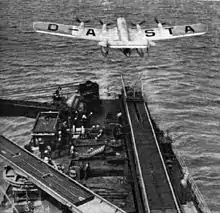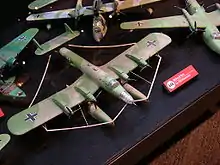Blohm & Voss Ha 139
The Blohm & Voss Ha 139 was a German all-metal inverted gull wing floatplane. With its four engines it was at the time one of the largest float-equipped seaplanes that had been built. The inboard engines were mounted at the joint between the inboard anhedral and outboard dihedral wing sections, above the pylon-mounted floats.
| Ha 139 | |
|---|---|
 | |
| Ha 139 Nordwind in 1938 | |
| Role | mail/cargo plane |
| Manufacturer | Blohm & Voss |
| First flight | October 1936 |
| Introduction | 1937 |
| Primary user | Deutsche Luft Hansa |
| Produced | 1936–1938 |
| Number built | 3 |
| Variants | Blohm & Voss BV 142 |
Further development of the Ha 139 led to the land-based version Blohm & Voss BV 142 which had its first flight in October 1938.
Operational history
.jpg.webp)
The aircraft were flown by Deutsche Luft Hansa on transatlantic routes between 1937 and 1939, predominately between Bathurst, The Gambia and Natal, Brazil. Catapult-launched from an aircraft tender they were able to transport 500 kg of mail over a distance of up to 5,000 km.
On the outbreak of World War II, the planes were transferred to the Luftwaffe and used for transport, reconnaissance and minesweeping work over the Baltic Sea. They were not particularly suited for military use.
Variants
Data from: Aircraft of the Third Reich[1]

- Projekt 15
- Catapult launched floatplane mail-carrier design for Deutsche Lufthansa (DLH), became the Ha 139.
- Projekt 20
- A reconnaissance-bomber derivative of Projekt 15 submitted to the Reichsluftfahrtministerium (RLM) (German air Ministry) but generating little interest.
- Ha 139 V1
- Named Nordwind — First of two baseline prototypes
- Ha 139 V2
- Named Nordmeer — Second of two baseline prototypes
- Ha 139 V3
- Named Nordstern — Third prototype with longer wingspan, increased wing area and modified engine mounts.
- Ha 139B
- The Ha 139 V3 re-designated when in service with DLH.
- Ha 139B/Umbau
- After service with DLH, the Ha 139B was modified as the Ha 139B/Umbau with an extended glazed nose accommodating a navigator and a spherical Ikaria mount for a machine-gun. Further machine guns were mounted in the cockpit roof hatch and in lateral mountings on either side of the rear fuselage.
- Ha 139B/MS
- The Ha 139B/Umbau was later modified into a minesweeping (Minensuch) aircraft fitted with a large magnetic sensing loop strung between the nose, floats, wing-tips, and tail unit.
Specifications (Ha 139B/Umbau)

Data from Green[1]
General characteristics
- Crew: 4–5
- Length: 20.07 m (65 ft 10 in)
- Wingspan: 29.5 m (96 ft 9 in)
- Height: 4.8 m (15 ft 9 in)
- Wing area: 130 m2 (1,400 sq ft)
- Empty weight: 10,340 kg (22,796 lb)
- Gross weight: 19,000 kg (41,888 lb)
- Powerplant: 4 × Junkers Jumo 205C 6-cyl. opposed piston diesel engines, 447 kW (599 hp) each for take-off
- Propellers: 3-bladed variable-pitch metal propellers
Performance
- Maximum speed: 288 km/h (179 mph, 156 kn) at 3,000 m (9,843 ft)
- Cruise speed: 238 km/h (148 mph, 129 kn) (maximum) at 2,000 m (6,562 ft)
- Economical cruise speed: 200 km/h (124 mph)
- Ferry range: 4,600 km (2,900 mi, 2,500 nmi) at 238 km/h (148 mph)
- 4,950 km (3,076 mi) at 200 km/h (124 mph)
- Rate of climb: 2.833 m/s (557.7 ft/min)
Armament
- Guns: 4 x 7.92 mm (0.312 in) MG 15 machine guns in nose, flight deck roof hatch, and staggered fuselage lateral mountings
References
- Notes
- Green, William (2010). Aircraft of the Third Reich (1st ed.). London: Aerospace Publishing Limited. p. 34. ISBN 978 1 900732 06 2.
- Bibliography
- Green, William. Warplanes of the Third Reich. London: Macdonald and Jane's Publishers Ltd., 4th impression 1979, p. 78–80. ISBN 0-356-02382-6.
- Smith J.Richard and Kay, Anthony. German Aircraft of the Second World War. London: Putnam & Company Ltd., 3rd impression 1978, p. 63–66. ISBN 0-370-00024-2.
- Wood, Tony and Gunston, Bill. Hitler's Luftwaffe: A pictorial history and technical encyclopedia of Hitler's air power in World War II. London: Salamander Books Ltd., 1977, p. 133. ISBN 0-86101-005-1.
- Green, William (2010). Aircraft of the Third Reich (1st ed.). London: Aerospace Publishing Limited. p. 34. ISBN 978 1 900732 06 2.
External links
| Wikimedia Commons has media related to Blohm & Voss Ha 139. |
